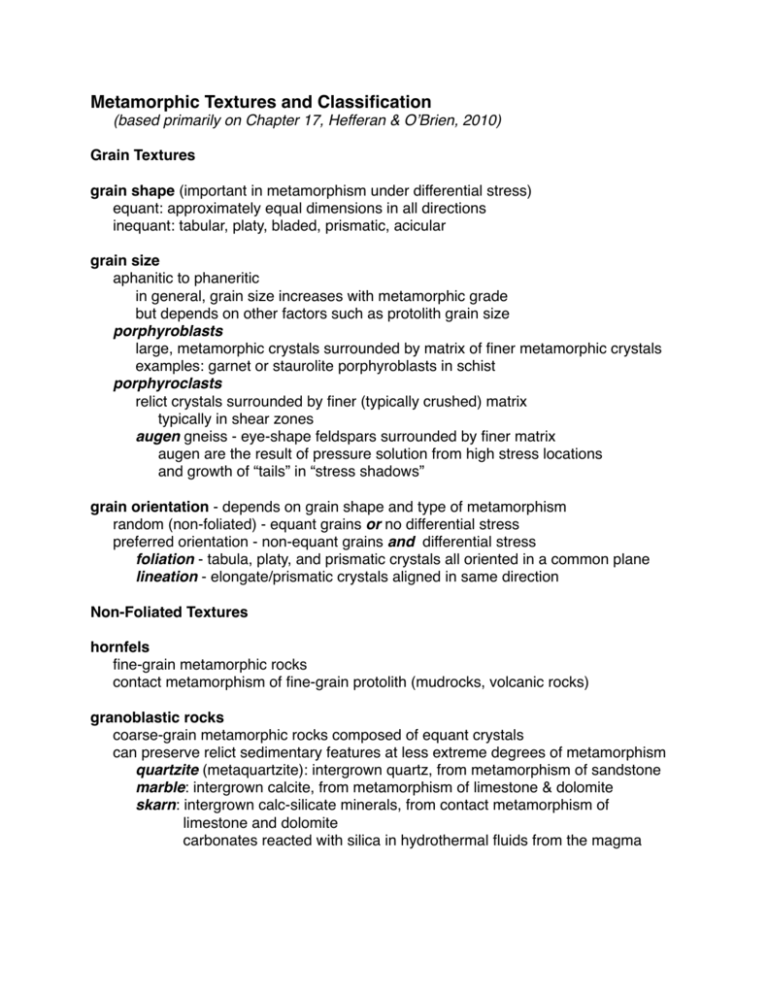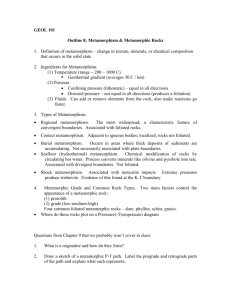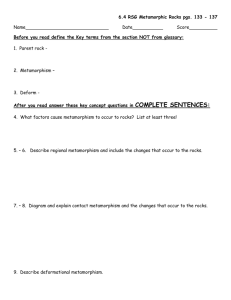Metamorphic Textures Summary
advertisement

Metamorphic Textures and Classification (based primarily on Chapter 17, Hefferan & OʼBrien, 2010) Grain Textures grain shape (important in metamorphism under differential stress) equant: approximately equal dimensions in all directions inequant: tabular, platy, bladed, prismatic, acicular grain size aphanitic to phaneritic ! in general, grain size increases with metamorphic grade ! but depends on other factors such as protolith grain size porphyroblasts ! large, metamorphic crystals surrounded by matrix of finer metamorphic crystals ! examples: garnet or staurolite porphyroblasts in schist porphyroclasts ! relict crystals surrounded by finer (typically crushed) matrix ! ! typically in shear zones ! augen gneiss - eye-shape feldspars surrounded by finer matrix ! ! augen are the result of pressure solution from high stress locations ! ! and growth of “tails” in “stress shadows”! ! grain orientation - depends on grain shape and type of metamorphism ! random (non-foliated) - equant grains or no differential stress ! preferred orientation - non-equant grains and differential stress ! foliation - tabula, platy, and prismatic crystals all oriented in a common plane ! lineation - elongate/prismatic crystals aligned in same direction Non-Foliated Textures hornfels fine-grain metamorphic rocks ! contact metamorphism of fine-grain protolith (mudrocks, volcanic rocks) granoblastic rocks coarse-grain metamorphic rocks composed of equant crystals can preserve relict sedimentary features at less extreme degrees of metamorphism ! quartzite (metaquartzite): intergrown quartz, from metamorphism of sandstone ! marble: intergrown calcite, from metamorphism of limestone & dolomite ! skarn: intergrown calc-silicate minerals, from contact metamorphism of ! ! limestone and dolomite ! ! carbonates reacted with silica in hydrothermal fluids from the magma cataclastic & non-crystalline textures metabreccia ! metamorphism of sedimentary or volcanic breccia ! or by dynamic metamorphism of rocks in a fault zone or impact structure cataclasite ! brittle cataclasis in fault zone or impact structure producing a cohesive matrix ! fault breccia (metabreccia) is a coarse-grain catclasite pseudotachylite ! mixed glass, devitrified glass, and sheared and brecciated rock in a fault ! ! or impact zone ! glass formed by rapid frictional heating, partial melting, and rapid solidification impactite - several related features of an extraterrestrial impact ! impact breccia: rock broken up by the impact ! shatter cones: downward and outward opening cones of fractured rock ! tektites: glass droplets (often devitrified) formed from melt ejected from impact ! shocked quartz: two sets of deformation lamella due to the intense pressure ! ultra-high pressure minerals: high pressure quartz (coesite & stishovite) transitional: non-foliated to foliated metaconglomerate ! metamorphosed conglomerate ! recrystallization of matrix means rock will now fracture across large clasts stretched pebble metaconglomerate ! flattened by compression or stretched by shearing ! elongate pebble may form either a foliation (flattening) or a lineation (shearing) serpentinite ! formed by hydrothermal metamorphism of ultramafic rocks at midocean ridges ! as well as in subduction zone and accretionary wedge settings ! produces hydrous serpentine group minerals (phylosilicates) soapstone ! fine-grain rock formed by hydrothermal metamorphism of Mg-rich ultramafic rock ! or Mg-rich carbonate (remember, ultramafic mantle rock is rich in Mg) ! contains talc (hydrated Mg silicate) plus serpentine ! very soft because of the talc (softest mineral) greenstone ! formed by hydrothermal metamorphism of midocean ridge basalt and gabbro ! Precambrian age greenstone belts formed from mafic and ultramafic crust ! contains chlorite, epidote, prehnite, pumpellyite, talc, serpentine, actinolite, albite ! ! all but albite are hydrous minerals - mostly amphiboles & phyllosilicates ! chlorite & epidote are green amphibolite ! form by high pressure & temp. metamorphism of mafic rocks (e.g., basalt) ! hornblende (amphibole) is dominant, with plagioclase, garnet plus others ! some foliated (e.g., Central Park amphibolite), some non-foliated (our big lump) ! granulite ! medium to coarse grain; granoblastic or foliated ! form by high pressure & temp metamorphism (hotter than for amphibolites) ! ! in lower continental crust ! dehydration reactions change hydrous amphiboles & micas ! ! into non-hydrous minerals pyroxene, kspar, kyanite & garnet eclogite ! form by very high pressure and temp metamorphism of basalt and gabbro ! ! from thickening of continental crust by collision ! ! crystallization of basaltic magma in the deep lower crust ! ! subduction of oceanic crust ! contain green jadeite (pryoxene) omphacite, and red garnet ! very high density, 3.5-4 g/cm3 textures of foliated metamorphic rocks slaty cleavage ! low grade metamorphism, 150-250 °C, of clay-rich rocks ! relatively shallow burial combined with compressive stress ! clays re-orient along with neocrystallization of micas ! at higher grades all clays recrystallized into micas ! microscopic clays and micas aligned in preferred orientation ! ! due to compression possibly combined with shearing ! the rock cleaves along this preferred alignment direction phyllitic cleavage ! a little higher grade metamorphism at 250-300 °C, of clay-rich rocks ! wavy foliation ! sheen due to small, just visible micas schistosity ! intermediate to high grade regional metamorphism, > 300 °C, of clay-rich rocks ! coarse-grained, wavy foliation ! as grade increases, phyllosilicates become less abundant ! ! and anhydrous minerals more abundant ! ! garnet then staurolite then kayanite form at progressively higher temperature ! the rock breaks roughly along the foliation gneissic banding ! high grade regional metamorphism to temperatures that may exceed 600 °C ! alternating bands of felsic quartz and feldspar ! ! with bands of mafic biotite and amphiboles like hornblende ! at higher grade amphiboles (hydrous) are replaced by pyroxenes (anhydrous) ! gneissic banding develops from various igneous and sedimentary protoliths ! ! orthogneiss forms from the metamorphism of an igneous protolith ! ! paragneiss forms by metamorphism of a sedimentary protolith migmatite ! at temperatures above ~700-800 °C partial melting of “wet” felsic rocks ! a composite of foliated (especially the mafic bands) and igneous (felsic) ! some migmatites my form by partial melting in place ! ! or by partial melting of deeper rocks and injection into higher rocks mylonite ! fine-grained matrix with elongated porphyroclasts ! formed in ductile shear zones ! both brittle grinding and plastic flow may occur








